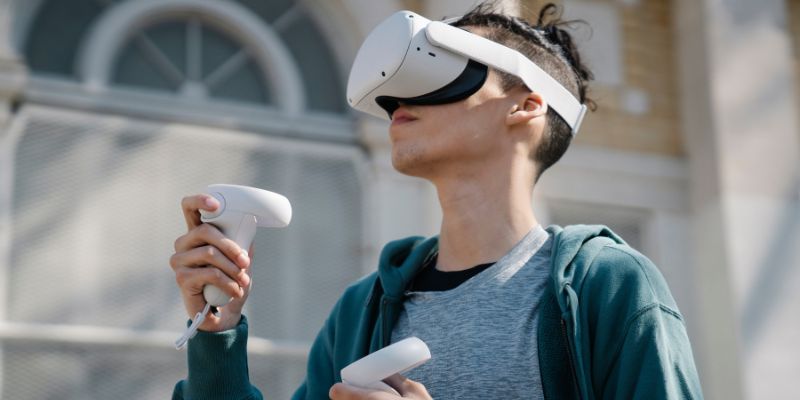Introduction
For the past few years, there has been a huge advancement in the field of computer and visualization (Niehorster and Lappe, 2017). The engineers keep discovering and introducing advanced and more effective ways to use technology. After 8K TV screens, the technology of VR has been introduced. The simulations which are generated by the computer are known as Virtual reality (Christensen, Annau, Van Hoff, Verizon Patent and Licensing, 2020). In VR an individual can interact with what is playing in the device. VR provides the user with a 3-dimensional environment, and the media playing in the VR looks almost like a real world. There are different gadgets in a VR set (Lorenzo, Lledó, Pomares and Roig, 2016). These gadgets are special eyewear with screens, controllers, or hand gloves with sensors. The technology of VR is growing in almost every part of the world.
Description
In the past few years, there has been an incensement in the applications of VR (Bhagat, Liou and Chang, 2016). VR users can experience a whole new world and also interact with it. The main purpose or feature if VR is to show the high-resolution data. The environment that individual experiences in a VR device are so realistic. But, there are different types of VR with different types of results (Osumi, Ichinose, Sumitani, Wake, Sano, Yozu, Kumagaya, Kuniyoshi and Morioka, 2017). Some provide a bit low-quality result which can only support some specific senses of the user. Some levels of immersion of VR in a sequence are:
Desktop VR
Desktop VR is a type of virtual reality device, which shows the result on a screen. The user can use the computer in a high resolution or virtual reality. These desktop VRs only include a pair of 3D glasses and a VR device (Boesen and Bragi, 2017). This is one of the basic types of VR applications. In desktop VR, there is no other sensor is used. For instance, there is no sensor gloves or any special hearing sensor in desktop VR.
Fish tank VR
Fish tank VR includes a headset or a head tracking device. The user using a fish tank VR can experience a parallax effect. In fish tank VR, monitors were used for an output source. Fish tank VR was the same as desktop VR in the matter of sensory. They also do not support any special sensing effect. These desktop VRs are an advanced type or generation of the desktop VR. In fish tank VR, for special stereoscopic viewing, they included shutter glasses. Fish tank VR does not give the user a 360-degree view. It depends on the viewer’s head position.
Immersive systems
In these VR, the aim or goal is to immerse the user in a computer-generated world and to make him a part of it. In immersive systems, an individual can participate and make his contribution and decisions in that computer-generated environment. Another advancement in the immersive system is introduced which is that these VRs are sensory applicable. The section of audio and haptics has also been advanced in immersive systems.
Applications of VR
In today’s world, the applications of VR are greatly increasing. It is not only used in the field of gaming or entertainment. Some of the VR applications are mentioned below.
VR in military
In the department of military training, the technology of virtual reality is used. Using VR for the training of soldiers will make them experience the situation or the environment of almost a real war or any fight. This helps them to learn and practice without being in a real environment of a battlefield. Otherwise, it will be risky and dangerous for the soldiers (Kalron, Fonkatz, Frid, Baransi and Achiron, 2016).
VR in sports
In the field of sports, there has always been some kind of advancement and betterment. It can be an advancement of equipment or coaching gadgets. In sports, virtual reality plays a vital role. VR has not been introduced in every sports field of every country. The technology of virtual reality in sports helps the coaches to teach players more efficiently. The players can experience a real situation before playing or participating in an actual game. This helps them learn more and better techniques for their team. Another use of VR in the field of sports is for those who cannot afford to visit a football stadium for watching a live match. They can easily watch it at their homes and can even be a part of it by the use of virtual reality.
VR in mental health cure
In the field of psychiatry, the technology of virtual reality turns out to be a great tool. By the use of virtual reality gadgets, the patients can experience a real-life situation, in which they can get rid of their anxiety or depression (Román-Ibáñez, Pujol-López, Mora-Mora, Pertegal-Felices and Jimeno-Morenilla, 2018). The physiatrist provides them a condition that makes the patient feel happy and apart from their stress and depression. It also helps those people having some kind of fear or phobia. Those patients experience and come into contact with the things they are afraid of. This is how VR is used as a meditation in the field of health (Borrego, Latorre, Llorens, Alcañiz and Noé, 2016). Another application of VR in the medical field, which is to train the new upcoming doctors.
Conclusion
Virtual reality is a technology that is used in the field of computer and visualization. The technology of virtual reality is getting better and more efficient over time. The main purpose of the virtual reality device is to let the user experience a three-dimensional world. The visualization in virtual reality device is almost like the real world. There are different types of VR. The first virtual reality setup as desktop VR. The desktop VR allows an individual to experience his computer screen in a high resolution. After that, the fish tank VR was introduced. It shows the result in parallax effects (Standen, Threapleton, Richardson, Connell, Brown, Battersby, Platts and Burton, 2017). After all these VRs, immersive systems were introduced. In immersive systems of virtual reality, the user can experience a three dimensioned world. In immersive systems, the user can use sensors. Such as, an individual can move his hand to control the movement in a VR.
Reference
- Niehorster, D.C., Li, L. and Lappe, M., 2017. The accuracy and precision of position and orientation tracking in the HTC vibe virtual reality system for scientific research. i-Perception, 8(3), p.2041669517708205.
- Christensen, J., Annau, T.M. and Van Hoff, A., Verizon Patent and Licensing Inc, 2020. Generating content for a virtual reality system. U.S. Patent 10,708,568.
- Lorenzo, G., Lledó, A., Pomares, J. and Roig, R., 2016. Design and application of an immersive virtual reality system to enhance emotional skills for children with autism spectrum disorders. Computers & Education, 98, pp.192-205.
- Bhagat, K.K., Liou, W.K. and Chang, C.Y., 2016. A cost-effective interactive 3D virtual reality system applied to military live firing training. Virtual Reality, 20(2), pp.127-140.
- Osumi, M., Ichinose, A., Sumitani, M., Wake, N., Sano, Y., Yozu, A., Kumagaya, S., Kuniyoshi, Y. and Morioka, S., 2017. Restoring movement representation and alleviating phantom limb pain through short‐term neurorehabilitation with a virtual reality system. European journal of pain, 21(1), pp.140-147.
- Boesen, P.V., Bragi GmbH, 2017. Earpiece 3D Sound Localization Using Mixed Sensor Array for Virtual Reality System and Method. U.S. Patent Application 15/290,845.
- Kalron, A., Fonkatz, I., Frid, L., Baransi, H. and Achiron, A., 2016. The effect of balance training on postural control in people with multiple sclerosis using the CAREN virtual reality system: a pilot randomized controlled trial. Journal of neuroengineering and rehabilitation, 13(1), p.13.
- Román-Ibáñez, V., Pujol-López, F.A., Mora-Mora, H., Pertegal-Felices, M.L. and Jimeno-Morenilla, A., 2018. A low-cost immersive virtual reality system for teaching robotic manipulators programming. Sustainability, 10(4), p.1102.
- Borrego, A., Latorre, J., Llorens, R., Alcañiz, M. and Noé, E., 2016. Feasibility of a walking virtual reality system for rehabilitation: objective and subjective parameters. Journal of neuroengineering and rehabilitation, 13(1), p.68.
- Standen, P.J., Threapleton, K., Richardson, A., Connell, L., Brown, D.J., Battersby, S., Platts, F. and Burton, A., 2017. A low cost virtual reality system for home based rehabilitation of the arm following stroke: a randomised controlled feasibility trial. Clinical rehabilitation, 31(3), pp.340-350.




